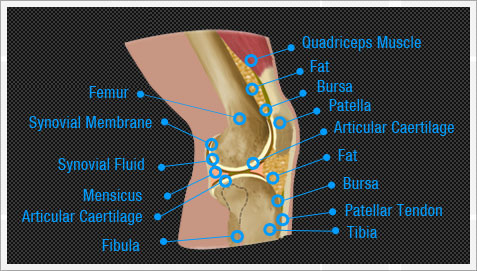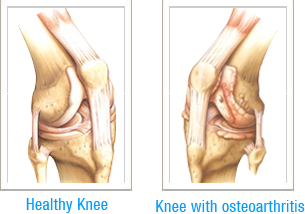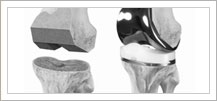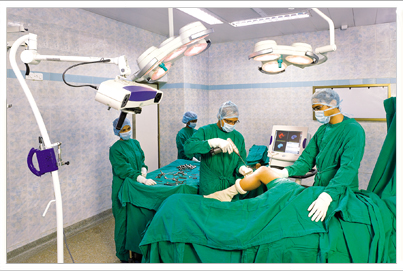 MIOT Hospitals is pioneer in knee replacement surgeries with 37 years of experience.
MIOT Hospitals is pioneer in knee replacement surgeries with 37 years of experience.
Knee Surgery Procedures
- Home
- Knee Surgery Procedures
-
Knee Replacement
Read more -
Knee Conditions
Details Arthritis is not a symptom of “just getting old”
Arthritis is not a symptom of “just getting old” -
Why Knee Replacement Surgery
Details You need your knee to stand, sit and squat. MIOT dreams of a world where you are pain free.
You need your knee to stand, sit and squat. MIOT dreams of a world where you are pain free. -
Knee Surgery Procedures
Details Explore a range of hip replacement procedures.
Explore a range of hip replacement procedures. -
Preparation for Surgery
Details Replacing arthritic joints has really come of age with this introduction of computer navigation.
Replacing arthritic joints has really come of age with this introduction of computer navigation. -
Knee Replacement Surgery Information
Details Knee Replacement Surgery Information
Knee Replacement Surgery Information -
Hospital Stay
Details While you’re at MIOT, we prepare you before the surgery, operate and treat you further.
While you’re at MIOT, we prepare you before the surgery, operate and treat you further. -
Recovering at Home
Details Your knee replacement should give you years of service protect it by taking few simple steps.
Your knee replacement should give you years of service protect it by taking few simple steps. -
How much would it cost?
Details Knee replacement surgery cost varies with the type of implant and the knee condition.
Knee replacement surgery cost varies with the type of implant and the knee condition. -
Videos
Details Explore knee replacement surgery videos.
Explore knee replacement surgery videos. -
FAQ
Details Got questions? Read on to have your queries answered.
Got questions? Read on to have your queries answered. -
Enquire online
Details Leave us an enquiry for our expert’s opinion.
Leave us an enquiry for our expert’s opinion.
The knee joint is among the strongest, largest and most complex joints of the body. Whenever you walk, sit, squat, turn around, drive or perform many other seemingly simple movements, you are depending on the knee for support and mobility. When your knee is healthy, you may take it for granted, not giving a thought about the job it does for you. But once it starts to become painful, stiff, and you are forced to restrict certain activities, you may come to realize how much freedom of movement means to you.
Fortunately, today’s advanced medical technology makes it possible to replace the knee joint with an artificial one that reduces pain, allows you to strengthen your legs, and improves your quality of life.
Knee replacement is a procedure commonly performed throughout the world, and one that offers an outstanding rate of success.
How your knee joint functions
 The healthy knee. The healthy knee joint is a remarkable mechanism. It is formed by the bottom end of the femur (thigh bone), the top end of the tibia (shin bone) and the patella (knee cap). A healthy knee joint has cartilage between the bones that acts as padding. This padding helps assure a gliding movement of the knee that is both effortless and smooth. The healthy knee joint also has a joint capsule which houses the synovial membrane. This membrane procedure lubricating fluid which contributes to the smooth movement of the knee. The human knee is designed to withstand a lifetime of stressful activity. However, sometimes arthritis intrudes, interfering with the knee’s ability to cushion the body from stress, and eventually causing the pain that dramatically erodes your quality of life.
The healthy knee. The healthy knee joint is a remarkable mechanism. It is formed by the bottom end of the femur (thigh bone), the top end of the tibia (shin bone) and the patella (knee cap). A healthy knee joint has cartilage between the bones that acts as padding. This padding helps assure a gliding movement of the knee that is both effortless and smooth. The healthy knee joint also has a joint capsule which houses the synovial membrane. This membrane procedure lubricating fluid which contributes to the smooth movement of the knee. The human knee is designed to withstand a lifetime of stressful activity. However, sometimes arthritis intrudes, interfering with the knee’s ability to cushion the body from stress, and eventually causing the pain that dramatically erodes your quality of life.
Common reasons for Knee Replacement
Total knee replacement surgery is considered for patients whose knee joints have been damaged by progressive arthritis, trauma, or other rare destructive diseases of the joint.
The knee joint is a hinge joint. The surface of the bones are covered with cartilage which enables smooth movement of the knee. When this cartilage gets damaged due to various reasons it exposes the underlying bone leading to pain, swelling, stiffness and deformity in the knee. This is arthritis.
What causes arthritis?
 There are more than 200 causes for arthritis. But the most commonly seen are:
There are more than 200 causes for arthritis. But the most commonly seen are:
Degenerative osteoarthritis due to the wear and tear of aging
Rheumatoid arthritis.
Gouty arthritis
Post traumatic arthritis -Any neglected or poorly treated fractures or problems can result in arthritis at a later date.
Who can get this problem?
 Anybody can suffer from arthritis. Degenerative arthritis and Gouty arthritis are usually seen after the age of 40-50 yrs. But Rheumatoid arthritis affects even children and some of them become crippled even at age 15 or 20.
Anybody can suffer from arthritis. Degenerative arthritis and Gouty arthritis are usually seen after the age of 40-50 yrs. But Rheumatoid arthritis affects even children and some of them become crippled even at age 15 or 20.
How did they find a solution?
The concept of improving joint function by modifying the articular surfaces received attention since the 19th century. Pig’s bladder, nylon, cellophane etc., were tried in between the worn out surfaces of the bones. But the results were disappointing. Then the worn out surfaces were resected (sliced off). This provided good motion but lacked necessary stability.
Then one side of the joint was changed in the 1950’s but the results were not satisfactory. Finally in the 1970’s the first tri compartmental knee replacement was performed. Ever since, the technology has improved tremendously. The implant design, material used, the surgical technique, everything has been fine tuned.
The goal today
Today the goal for standard total knee replacement is to provide a painfree, stable, well aligned, mobile (0-120 degree) joint.
The components of new knee joint
 In total knee replacement (also known as total knee arthroplasty, or TKA), the joint’s bone end surfaces are resurfaced with man-made materials. In total knee arthroplasy, the implant (prosthesis) design may vary according to your needs, but the most common implant consists of three component parts. The patella, or knee cap, is made of high-density polyethylene, which offers tremendous strength and durability. The femoral section, or thigh bone, is metal, while the tibia, or shin bone, is made of high-density polyethylene and may be supported by a metal tray.
In total knee replacement (also known as total knee arthroplasty, or TKA), the joint’s bone end surfaces are resurfaced with man-made materials. In total knee arthroplasy, the implant (prosthesis) design may vary according to your needs, but the most common implant consists of three component parts. The patella, or knee cap, is made of high-density polyethylene, which offers tremendous strength and durability. The femoral section, or thigh bone, is metal, while the tibia, or shin bone, is made of high-density polyethylene and may be supported by a metal tray.
How Total Knee Replacement is performed?
 Usually the total knee replacements are done under regional anaesthesia. After the patient is prepared, the skin is cut in the midline in front of the knee and the joint is opened.
Usually the total knee replacements are done under regional anaesthesia. After the patient is prepared, the skin is cut in the midline in front of the knee and the joint is opened.
The worn out cartilage and borne on the tibial articular surface is removed first. Then the focus turns on the soft tissue sleeves. The joint is surrounded on all the 4 sides by the soft tissue envelope. Due to deformity the tissues on the concave side of the envelope usually get contracted and those on the convex side, get stretched. As in the case of car tyres, changing the tyres alone is not sufficient but the alignment of the wheels are also important for the longevity of the tyres.
Similarly equal tension on all the 4 sides of the soft tissue envelope, as well as proper alignment of the limb must be achieved. This is done by releasing the tissues on the contracted side to the equal length of the tissues on the convex side.
The worn out cartilage and borne on the tibial articular surface is removed first. Then the focus turns on the soft tissue sleeves. The joint is surrounded on all the 4 sides by the soft tissue envelope. Due to deformity the tissues on the concave side of the envelope usually get contracted and those on the convex side, get stretched. As in the case of car tyres, changing the tyres alone is not sufficient but the alignment of the wheels are also important for the longevity of the tyres. Similarly equal tension on all the 4 sides of the soft tissue envelope, as well as proper alignment of the limb must be achieved. This is done by releasing the tissues on the contracted side to the equal length of the tissues on the convex side.
Then the worn out bone and cartilage on the femur is removed to match the thickness of the implants and an equal flexion and extension gaps are achieved. The knee cap also is prepared.
And finally the original implants are fixed to the bone using bone cement. The wound is closed. Post-operative pain relief is provided by the epidural analgesia or by the femoral block.
Patients can stand and walk the same day. Before they leave the hospital (usually on 10th day), they will have at least 0-90 degrees movement in the knee. They should be able to climb stairs and walk independently. The sutures will be removed around the 12th day. In a months time the patient can get back their full function and they can even play tennis with their new knees!
Benefits of knee joint replacement
- Once the new joint has completely healed, the patient will reap the benefits of the surgery. These include:
- Reduced joint pain (maybe no pain!)
- Increased movement and mobility
- Correction of deformity
- Increased leg strength (if you exercise)
- Improved quality of life ability to return to normal activities and pastimes. Most likely, running, jumping, or other high – impact activities will be discouraged.
Risks of knee joint replacement surgery
As with any major surgery, there are potential risks involved. It is important that the patients are informed of these risks before the surgery takes place.
Infection. Because a bacterial infection from the mouth could infect the new joint, the patient will be asked to complete all dental work before surgery.
What's the challenge today?
As the life span of people increased and more and more young people were suffering from this problem, the challenge the surgeons began facing is the longevity of the joints.
A review of thousands of knee replacements all over the world revealed that accurate placement of the components, proper restoration of the mechanical axis of the lower limb and a good soft tissue balancing were the important deciding factors for the long term survival of the implant
So, in a total knee replacement the surgeons required technical assistance to achieve uniform results. This was made possible with computer navigation system. The computer navigation helps to place the artificial joints with zero degree error, restores proper alignment and good soft tissue balancing is achieved. With this the total knee replacement now-a-days can survive easily more than 20 years.
